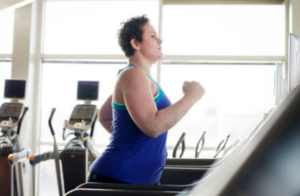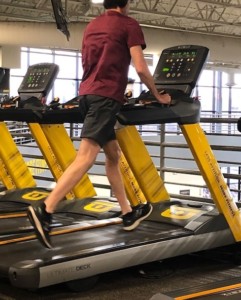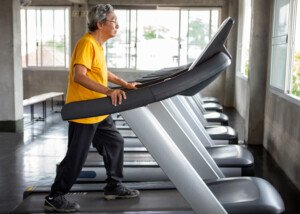Do you hold onto the bar in front when you run on a treadmill?
Stop this. It’s giving you a false sense of accomplishment and will never carry over to outdoor or court running.
Even if you’ve been holding onto the bar for many years, this habit is just as bad as if you’d just begun doing it only a few months ago.
Imagine running outside, either across a parking lot in the rain, to catch a bus, to chase after your dog, to bolt towards a situation in which someone needs help, or even in an airport to make your flight.
In any of these cases, your body will be postured a certain way; your hips, shoulders and arms will be moving a certain way; your feet will be striking the ground a certain way.
And this is the way nature designed the body to run, jog or canter.
If you hold onto the treadmill’s front bar (or rails or console) while running, this completely alters the biomechanics of your body. And for the worse.
“Holding onto the front bar while running totally changes the mechanics of running,” says Dr. Megan McLain, PT, DPT, cofounder of Intuitive Choice Physical Therapy & Wellness in Atlanta, GA.
“You lose trunk rotation, decrease work in your upper body and core, and cheat yourself out of a normal alignment and balance,” continues Dr. McLain.
“Over time this will decrease your ability to run over uneven ground or even on a road or trail, because you are altering the form so drastically.”
• The upper body is locked up.
• The hips are forced to over-rotate.
• The foot strike is unnatural.
These factors can result in repetitive stress injuries that you may not even connect to the habit of holding on.
Instead you might blame the recurring ache in your hip or shoulder on your golf game or some other activity, when in fact, it’s from the gait alteration that occurs from holding onto a treadmill.
Furthermore, when we run naturally, our core is engaged.
The core (trunk and lower back) unites the upper and lower body, helping them work together during ambulation.
Holding onto a treadmill disrupts this connection.
Holding on, whether it’s the front bar or elsewhere, disconnects the core, depriving it of its natural role in running.
Want proof that the core is significantly involved in running?
Check out the abs of not only competitive sprinters, but of competitive middle and long distance runners, and soccer and lacrosse players. I needn’t say more.
Natural running involves arm motion that is deactivated when you hang onto the bar.
So now we have the upper arms and the core being relieved of their duties when you run gripping a treadmill.
However, the shoulders, arms and hands DO work to help support your body when you hold onto the machine.
This cheats the legs of some work — work that they need to be doing.
What you ultimately have, then, is make-believe running.
It will not transfer over to outdoor or court running.
“A good workout is functional and mimics movements that you perform during your daily activities,” says Dr. McLain.
“This is the best way to prevent injuries and be able to perform your daily activities with ease over the long-term.
“If you hold on, you’re robbing yourself of the opportunity to practice coordination and balance, and also possibly leading to muscle imbalances, especially if you have to lean forward or backward to comfortably hold the front bar while running.
“This also will lead to a shorter stride and unnatural foot strike, which changes the way ground forces are distributed up your legs, which can lead to injuries of your foot, knee or hips over time from the unnatural movement.”
Now maybe you don’t care about one day having to run down a street or through an airport, and maybe you have no plans of participating in court or field sports.
Maybe all you want is to get your heart rate elevated.
But regardless of your goal, you may still suffer repetitive stress injuries – if you already don’t have a stubborn pain somewhere that doesn’t respond to therapy exercises.
Nevertheless, many people who hold onto the bar in front would like to improve their capability at running. This won’t happen unless you LET GO.

If you went for a run outside, you wouldn’t be clinging onto anything. So why do this on an indoor machine? Makes no sense.
As for those wanting to lose weight, if you let go of the bar, you’ll burn a lot more calories.
The calorie readout is the same no matter what you do on the treadmill because it’s determined by the speed (and incline) ONLY.
Don’t Fool Yourself Any Longer
Remove your hands from the treadmill.
Don’t be surprised if you can’t last longer than a few minutes at the same speed without holding onto that bar.
But this should tell you something:
Holding on is make-believe running and cheats your body of becoming truly more efficient at running.
Solution? Use a Slower Speed
Set the speed slower.
Your core, hips and legs are now working harder – the way they should be, which is why removing your hands makes the workout more challenging.
Is holding on at a faster speed the same as letting go at a slower speed?
NO. NEVER.
Remember, your gait – your movement mechanics – is significantly altered when you hold on, especially at faster speeds.
Hands-free restores your body’s natural movement mechanics. It’s far better to jog at 3 mph without holding onto the bar than it is to “run” at 7 mph holding ON.
And who knows, maybe one day you WILL have to take off in a run outdoors. And you’ll be so glad you scored at this as a result of keeping your hands off the treadmill!


 Dr. Megan McLain, PT, DPT,
Dr. Megan McLain, PT, DPT,























